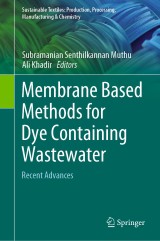Details

Membrane Based Methods for Dye Containing Wastewater
Recent AdvancesSustainable Textiles: Production, Processing, Manufacturing & Chemistry
|
96,29 € |
|
| Verlag: | Springer |
| Format: | |
| Veröffentl.: | 13.10.2021 |
| ISBN/EAN: | 9789811648236 |
| Sprache: | englisch |
| Anzahl Seiten: | 303 |
Dieses eBook enthält ein Wasserzeichen.
Beschreibungen
<p>This book highlights recent findings of membrane - based dye removal methods along with the application of photocatalytic, nanofiltration and ultrafiltration membrane including membrane – based fibers, metal-organic frameworks, polyethersulfone, ceramic, etc. Among water and wastewater pollutants, dyes have been normally observed and detected in various aquatic solutions, including rivers and lakes. Aesthetic pollution, toxicity, persistent, and carcinogenicity are some of the adverse effects of dyes entering the ecosystem. Although dyes have brought a colourful world, their presence in the environment are responsible for adverse effects on the planet. Diverse physical, chemical and biological methods are available to treat dye contaminated water. This book presents membrane separation technology that has been developed in the past decade to treat different wastewaters, and owning to its effective performance, has garnered the attention of academia and industry alike.</p>
An Introduction to Membrane-Based Systems for Dye Removal.- Technical Aspects of Nanofiltration for Dyes Wastewater Treatment.- Application of Ultrafiltration Membrane Technology for Removal of Dyes from Wastewater.- Progression and Application of Photocatalytic Membrane Reactor for Dye Removal: An Overview.- Fibrous Membranes for Water Purification: Focusing on Dye Removal.- Preparation and Application of Chitosan-based Membrane: Focusing on Dye Removal.- Lignin-based Membrane for Dye Removal.- Metal-Organic Frameworks Membranes.- Polyethersulfone and Its Derivatives as Membrane Materials for Dye Removal from Water.- Crosslinked Polymer-Based Adsorbents and Membranes for Dye Removal.- Ceramic Nanocomposite Membranes for Dye Removal.
<p><b>Dr. Subramanian Senthilkannan Muthu</b> currently works for SgT Group as Head of Sustainability, and is based out of Hong Kong. He earned his PhD from The Hong Kong Polytechnic University, and is a renowned expert in the areas of Environmental Sustainability in Textiles & Clothing Supply Chain, Product Life Cycle Assessment (LCA) and Product Carbon Footprint Assessment (PCF) in various industrial sectors. He has five years of industrial experience in textile manufacturing, research and development and textile testing and over a decade's of experience in life cycle assessment (LCA), carbon and ecological footprints assessment of various consumer products. He has published more than 100 research publications, written numerous book chapters and authored/edited over 100 books in the areas of Carbon Footprint, Recycling, Environmental Assessment and Environmental Sustainability.</p>
<p><b>Ali Khadir</b> is an environmental engineer and a member of the Young Researcher and Elite Club, Islamic Azad University of Shahre Rey Branch, Tehran, Iran. He has published/prepared several articles and book chapters in reputed international publishers, including Elsevier, Springer, Taylor & Francis and Wiley. His articles have been published in journals with IF greater than 4, including Journal of Environmental Chemical Engineering and International Journal of Biological Macromolecules. He also has been the reviewer of journals and international conferences. His research interests center on emerging pollutants, dyes and pharmaceuticals in aquatic media, advanced water and wastewater remediation techniques and technology. At present, he is editing other books in the field of nanocomposites, advanced materials, and the remediation of dye – containing wastewaters.</p>
<p><b>Ali Khadir</b> is an environmental engineer and a member of the Young Researcher and Elite Club, Islamic Azad University of Shahre Rey Branch, Tehran, Iran. He has published/prepared several articles and book chapters in reputed international publishers, including Elsevier, Springer, Taylor & Francis and Wiley. His articles have been published in journals with IF greater than 4, including Journal of Environmental Chemical Engineering and International Journal of Biological Macromolecules. He also has been the reviewer of journals and international conferences. His research interests center on emerging pollutants, dyes and pharmaceuticals in aquatic media, advanced water and wastewater remediation techniques and technology. At present, he is editing other books in the field of nanocomposites, advanced materials, and the remediation of dye – containing wastewaters.</p>
This book highlights recent findings of membrane - based dye removal methods along with the application of photocatalytic, nanofiltration and ultrafiltration membrane including membrane – based fibers, metal-organic frameworks, polyethersulfone, ceramic, etc. Among water and wastewater pollutants, dyes have been normally observed and detected in various aquatic solutions, including rivers and lakes. Aesthetic pollution, toxicity, persistent, and carcinogenicity are some of the adverse effects of dyes entering the ecosystem. Although dyes have brought a colourful world, their presence in the environment are responsible for adverse effects on the planet. Diverse physical, chemical and biological methods are available to treat dye contaminated water. This book presents membrane separation technology that has been developed in the past decade to treat different wastewaters, and owning to its effective performance, has garnered the attention of academia and industry alike.
Highlights recent findings of membrane and photocatalytic-based dye removal methods from wastewater Presents membrane separation technology that has been developed in the past decade to treat different wastewaters Includes materials such as ceramic, chitosan, lignin, and polyethersulfone and their applications in dye removal
Diese Produkte könnten Sie auch interessieren:

Neutron Applications in Earth, Energy and Environmental Sciences

von: Liyuan Liang, Romano Rinaldi, Helmut Schober

149,79 €

Nanobioelectronics - for Electronics, Biology, and Medicine

von: Andreas Offenhäusser, Ross Rinaldi

96,29 €














